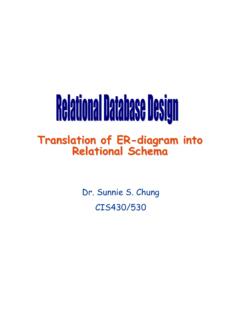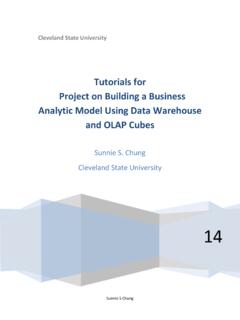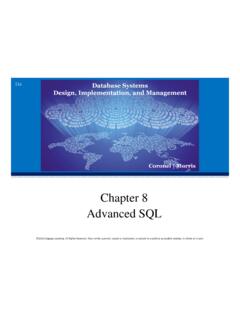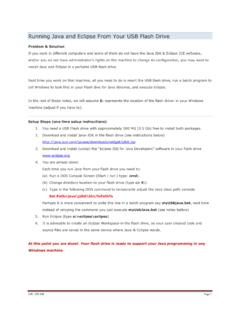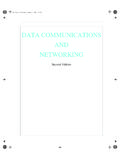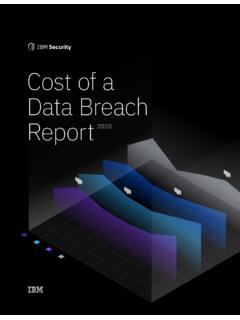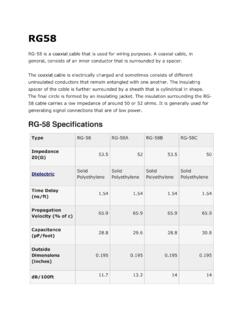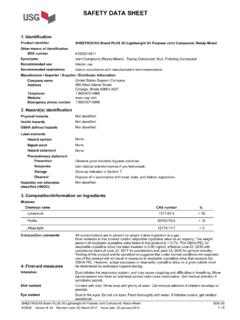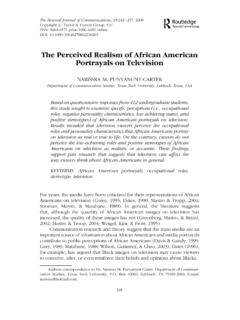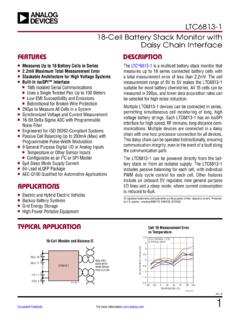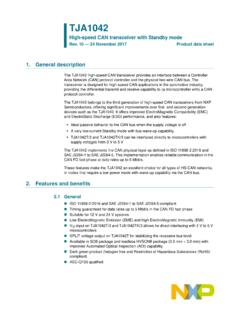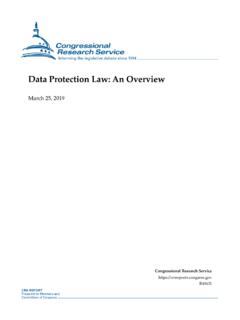Transcription of Chapter 2 Data Models - Cleveland State University
1 Database SystemsDesign, Implementation, and Management11e 2015 Cengage Learning. All Rights Reserved. May not be scanned, copied or duplicated, or posted to a publicly accessible website, in whole or in 2 data Models 2015 Cengage Learning. All Rights Reserved. May not be scanned, copied or duplicated, or posted to a publicly accessible website, in whole or in Objectives In this Chapter , you will learn: About data modeling and why data Models are important About the basic data -modeling building blocks What business rules are and how they influence database design2 2015 Cengage Learning. All Rights Reserved. May not be scanned, copied or duplicated, or posted to a publicly accessible website, in whole or in Objectives In this Chapter , you will learn: How the major data Models evolved About emerging alternative data Models and the need they fulfill How data Models can be classified by their level of abstraction3 2015 Cengage Learning.
2 All Rights Reserved. May not be scanned, copied or duplicated, or posted to a publicly accessible website, in whole or in Modeling and data Models data modeling: Iterative and progressive process of creating a specific data model for a determined problem domain data Models : Simple representations of complex real-world data structures Useful for supporting a specific problem domain Model- Abstraction of a real-world object or event4 2015 Cengage Learning. All Rights Reserved. May not be scanned, copied or duplicated, or posted to a publicly accessible website, in whole or in of data ModelsAre a communication tool Give an overall view of the databaseOrganize data for various usersAre an abstraction for the creation of good database5 2015 Cengage Learning. All Rights Reserved. May not be scanned, copied or duplicated, or posted to a publicly accessible website, in whole or in Model Basic Building Blocks Entity: Unique and distinct object used to collect and store data Attribute: Characteristic of an entity Relationship: Describes an association among entities One-to-many (1:M) Many-to-many (M:N or M:M) One-to-one (1:1) Constraint: Set of rules to ensure data integrity6 2015 Cengage Learning.
3 All Rights Reserved. May not be scanned, copied or duplicated, or posted to a publicly accessible website, in whole or in RulesBrief, precise, and unambiguous description of a policy, procedure, or principleEnable defining the basic building blocks Describe main and distinguishing characteristics of the data7 2015 Cengage Learning. All Rights Reserved. May not be scanned, copied or duplicated, or posted to a publicly accessible website, in whole or in of Business RulesCompany managersPolicy makersDepartment managersWritten documentationDirect interviews with end users8 2015 Cengage Learning. All Rights Reserved. May not be scanned, copied or duplicated, or posted to a publicly accessible website, in whole or in for Identifying and Documenting Business Rules Help standardize company s view of data Communications tool between users and designers Allow designer to: Understand the nature, role, scope of data , and business processes Develop appropriate relationship participation rules and constraints Create an accurate data model9 2015 Cengage Learning.
4 All Rights Reserved. May not be scanned, copied or duplicated, or posted to a publicly accessible website, in whole or in Business Rules into data Model Components Nouns translate into entities Verbs translate into relationships among entities Relationships are bidirectional Questions to identify the relationship type How many instances of B are related to one instance of A? How many instances of A are related to one instance of B?10 2015 Cengage Learning. All Rights Reserved. May not be scanned, copied or duplicated, or posted to a publicly accessible website, in whole or in Conventions Entity names - Required to: Be descriptive of the objects in the business environment Use terminology that is familiar to the users Attribute name - Required to be descriptive of the data represented by the attribute Proper naming: Facilitates communication between parties Promotes self-documentation11 2015 Cengage Learning.
5 All Rights Reserved. May not be scanned, copied or duplicated, or posted to a publicly accessible website, in whole or in and Network ModelsHierarchical ModelsNetwork Models Manage large amounts of data for complex manufacturing projects Represented by an upside-down tree which contains segments Segments: Equivalent of a file system s record type Depicts a set of one-to-many (1:M) relationships Represent complex data relationships Improve database performance and impose a database standard Depicts both one-to-many (1:M) and many-to-many (M:N) relationships12 2015 Cengage Learning. All Rights Reserved. May not be scanned, copied or duplicated, or posted to a publicly accessible website, in whole or in ModelAdvantagesDisadvantages Promotes data sharing Parent/child relationship promotes conceptual simplicity and data integrity Database security is provided and enforced by DBMS Efficient with 1:M relationships Requires knowledge of physical data storage characteristics Navigational system requires knowledge of hierarchical path Changes in structure require changes in all application programs Implementation limitations No data definition Lack of standards13 2015 Cengage Learning.
6 All Rights Reserved. May not be scanned, copied or duplicated, or posted to a publicly accessible website, in whole or in ModelAdvantagesDisadvantages Conceptual simplicity Handles more relationship types data access is flexible data owner/member relationship promotes data integrity Conformance to standards Includes data definition language (DDL) and data manipulation language (DML) System complexity limits efficiency Navigational system yields complex implementation, application development, and management Structural changes require changes in all application programs14 2015 Cengage Learning. All Rights Reserved. May not be scanned, copied or duplicated, or posted to a publicly accessible website, in whole or in Database ConceptsSchema Conceptual organization of the entire database as viewed by the database administratorSubschema Portion of the database seen by the application programs that produce the desired information from the data within the database15 2015 Cengage Learning.
7 All Rights Reserved. May not be scanned, copied or duplicated, or posted to a publicly accessible website, in whole or in Database ConceptsData manipulation language (DML) Environment in which data can be managed and is used to work with the data in the databaseSchema data definition language (DDL) Enables the database administrator to define the schema components 16 2015 Cengage Learning. All Rights Reserved. May not be scanned, copied or duplicated, or posted to a publicly accessible website, in whole or in Relational Model Produced an automatic transmission database that replaced standard transmission databases Based on a relation Relation ortable: Matrix composed of intersecting tuple and attribute Tuple: Rows Attribute: Columns Describes a precise set of data manipulation constructs17 2015 Cengage Learning.
8 All Rights Reserved. May not be scanned, copied or duplicated, or posted to a publicly accessible website, in whole or in ModelAdvantagesDisadvantages Structural independence is promoted using independent tables Tabular view improves conceptual simplicity Ad hoc query capability is based on SQL Isolates the end user from physical-level details Improves implementation and management simplicity Requires substantial hardware and system software overhead Conceptual simplicity gives untrained people the tools to use a good system poorly May promote information problems18 2015 Cengage Learning. All Rights Reserved. May not be scanned, copied or duplicated, or posted to a publicly accessible website, in whole or in Database Management System(RDBMS) Performs basic functions provided by the hierarchical and network DBMS systems Makes the relational data model easier to understand and implement Hides the complexities of the relational model from the user19 2015 Cengage Learning.
9 All Rights Reserved. May not be scanned, copied or duplicated, or posted to a publicly accessible website, in whole or in - A Relational DiagramCengage Learning 2015 20 2015 Cengage Learning. All Rights Reserved. May not be scanned, copied or duplicated, or posted to a publicly accessible website, in whole or in Relational Database Application End-user interface Allows end user to interact with the data Collection of tables stored in the database Each table is independent from another Rows in different tables are related based on common values in common attributes SQLengine Executes all queries21 2015 Cengage Learning. All Rights Reserved. May not be scanned, copied or duplicated, or posted to a publicly accessible website, in whole or in Entity Relationship Model Graphical representation of entities and their relationships in a database structure Entity relationship diagram (ERD) Uses graphic representations to model database components Entity instance or entity occurrence Rows in the relational table Connectivity: Term used to label the relationship types22 2015 Cengage Learning.
10 All Rights Reserved. May not be scanned, copied or duplicated, or posted to a publicly accessible website, in whole or in Relationship ModelAdvantagesDisadvantages Visual modeling yields conceptual simplicity Visual representation makes it an effective communication tool Is integrated with the dominant relational model Limited constraint representation Limited relationship representation No data manipulation language Loss of information content occurs when attributes are removed from entities to avoid crowded displays23 2015 Cengage Learning. All Rights Reserved. May not be scanned, copied or duplicated, or posted to a publicly accessible website, in whole or in - The ER Model Notations24 2015 Cengage Learning. All Rights Reserved. May not be scanned, copied or duplicated, or posted to a publicly accessible website, in whole or in Object-Oriented data Model (OODM) or Semantic data Model Object-oriented database management system(OODBMS) Based on OODM Object: Contains data and their relationships with operations that are performed on it Basic building block for autonomous structures Abstraction of real-world entity Attributes - Describe the properties of an object25 2015 Cengage Learning.

